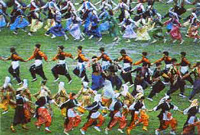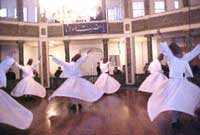 |
| FOLK LITERATURE
Composed of "Tekke" and "Asik," works of literary worth, often anonymous and passed down from generation to generation. These include epics, legends, folk poems, ballads, elegies, folk songs, riddles, folk tales anecdotes, proverbs, expressions and rhymes.
FOLK HEROES
Nasrettin Hoca
A 13th century humorist and sage from Aksehir. His witticisms are known throughout Turkey and often appear in conversation.
Karagoz
A jester, said to have lived in Bursa in the 14th century and now immortalized as a shadow puppet. Karagoz is a rough man of the people who uses his ribald wit to get the better of his pompous friend, Hacivat. The puppets are made from gaily painted, translucent animal skins and are projected onto a white screen.
Yunus Emre
The 13th century philosopher poet, one of Turkey's national treasures, promoted basic themes of universal love, friendship, brotherliness and divine Justice. His simple and pure writing is relevant and thought-provoking to this day.
Koroglu
A 15th century folk poet, Koroglu was a role model for his contemporaries and a hero of his time. His adventures have been recounted for centuries and perhaps now with more interest than ever. Koroglu was one of the first people to pioneer the ideal of unconditional help for the poor and down trodden. He was also spoke out against government control and harassment. |
|
| FOLK DANCES
Folk dances have different characteristics based on region and location and are generally engaged in during weddings, journeys to the mountains in the summer, when sending sons off to military service and during religious and national holidays. The best known folk dances are: |
|
 |
|
Horon
This Black Sea dance is performed by men only, dressed in black with silver trimmings. The dancers link arms and quiver to the vibrations of the kemence, a primitive type of violin.
Kasik Oyunu
The Spoon Dance is performed from Konya to Silifke and consists of gaily dressed male and female dancers clicking out the dance rhythm with a pair of wooden spoons in each hand.
Kilic Kalkan
The Sword and Shield Dance of Bursa represents the Ottoman conquest of the city. It is performed by men only, dressed in early Ottoman battle dress, who dance to the sound of clashing swords and shields without music.
Zeybek
In this Aegean dance, colorfully dressed male dancers, called 'efe', symbolize courage and heroism. |
|
 |
|
FOLK MUSIC
The lively Turkish folk music, which originated on the steppes of Asia, is in complete contrast to the refined Turkish classical music of the Ottoman court. Until recently, folk music was not written down, and the traditions have been kept alive by the 'asiklar', or Turkish troubadours. |
|
| Distinct from Turkish folk music is Ottoman military music, now performed by the 'mehter takimi' (Janissary Band) in Istanbul, which originated in Central Asia, and is played with kettle drums, clarinets, cymbals and bells.
The mystical music of the Whirling Dervishes is dominated by the haunting sound of the reed pipe or 'ney', and can be heard in Konya during the Mevlana Festival in December.
PERFORMING ARTS
There are six varieties of traditional Turkish performing arts:
Village Plays
Plays are put on in accordance with rural traditions on special days, weddings and holidays.
Meddah
A kind of one-act dramatic play where the narrator also imitates the various characters in the play.
Karagoz
Traditional show theatre, where the shadows of human and animal figures, cut out of leather and colored, are thrown onto a white curtain using a light source behind it.
Orta Oyun
In style and theme resembles Karagoz, but is performed by real actors.
Tuluat Theater
A mixture of Orta Oyun and western theater. |
|
|
 |
|
|
|